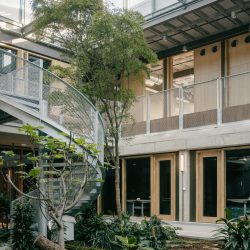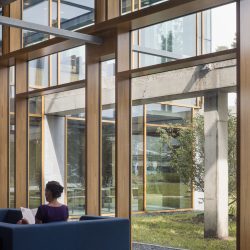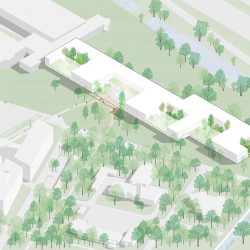
ITC, the International Institute for Geo-Information Sciences, is a standout faculty within the University of Twente. Students pursuing Master’s and PhD degrees, alongside researchers worldwide, gather in Enschede to explore sustainable solutions. This faculty acts as their meeting place and sustainable icon. The building is designed by Civic Architects, VDNDP, Studio Groen+Schild and DS Landscape architects. It provides classrooms, labs, a study center, offices, a restaurant, and three courtyard gardens across a 13,605m² structure.
TRANSFORMATION
Sculptural demolition
The faculty opted for the transformation of ‘Langezijds,’ a former laboratory built in 1972, rather than new construction. Langezijd is exceptionally long (220m) and deep (38m), with a low ground floor and a high upper floor, giving it a distinctive character but rendering it unsuitable for modern education. The new design focuses on creating space and light within these constraints, not by adding but by removing: Four atria carved out of the structure provide greenery, fresh air, and daylight, making the building suitable for its new purpose in a single intervention.
The aesthetic of imperfection
University faculties often resemble generic office buildings. White stucco, suspended ceilings, neutrality is the magic word. The new ITC is just as flexible and functional as its counterparts but features a more specific architecture that embraces the imperfections of the existing building. The concrete ceiling, the brutalist structure including its blemishes and traces of use, remain visible. Saw cuts reveal where floors once were, and old columns stand like overgrown ruins in the atria. Oak facades and bamboo floors introduce warmth. The materials are robust, the details refined, and no paint is used. Construction is finishing; that’s the premise.
Renewd functionalism
The new design responds to the functionalist architecture of Langezijds. The existing structure has been repaired, interpreted, dismantled, and complemented with architectural prosthetics. Some functionalist principles have been unmistakably continued. Old and new, walls and stairs, fixtures and sprinklers – everything is designed on a grid of 1550mm. Distinctive details embody the power of technology; the sprinkler system and all electrical elements on the upper floor have been carefully kept in sight. The facade alternates between the original architecture with a concrete ground floor and a glass upper floor. Wooden frames clarify the building’s new purpose. The raised floor at the facade simultaneously serves as a seating edge with views over the campus.
CONNECTING WITH THE CAMPUS
Architecture of landscape
Langezijds is situated on the Drienerlo estate, a beautiful campus with standalone buildings in a green landscape. The design for ITC integrates landscape and architecture through the four atria. They connect the interior with the outdoors, nature with technology. One of the atria serves as the new entrance in the center of the building. The facade steps back here, the landscape folds inward, and trees grow into the building, giving the faculty a recognizable address at the intersection of two urban axes.
Drienerlo; laboratory of modern architectural history
Campus Drienerlo was designed in the 1960s by Willem van Tijen and Sam van Embden, who projected an abstract grid onto the organic landscape of the estate and introduced strict functional segregation. The first buildings – the Main Building, the Hogekamp, and Langezijds – were “autonomous machines in the landscape.” Later, a new generation of structuralist architects – Piet Blom, Herman Haan, Joop van Stigt – had the opportunity to work on the campus. Their buildings created a more fluid relationship with the landscape, connecting indoor and outdoor through shifts and patios, and scaling down the architecture. The new ITC design takes the next step in the campus’s architectural tradition. The basis is functional, the atria connect the building to the surroundings, and the architectural execution is rich and refined.
SUSTAINABLE ICON
Sustainable mission
The architecture symbolizes ITC’s global sustainable mission. Architecture follows climate, with the preservation of the “brutalist” structure at its core. Offices, with a stable temperature, are located on the cooler ground floor, and larger educational spaces are on the upper floor. Reused sunshades on the south side prevent overheating in the summer. Fresh air is naturally exhausted through the atria, which serve as the building’s green lungs.
The gardens of ITC
The atria serve as biotopes for flora and fauna, contributing to a stress-free work environment. The Wood, Water, and Stone Garden each have their unique character, adding color to the building. The landscape is generous, with plants and trees rooted in over a meter of soil, providing an ideal environment for (sub)tropical vegetation. The V-shaped glass roofs collect rainwater, visibly leading it into the gardens, where it infiltrates and is stored for plant irrigation.
Flexible installation concept
The design bundles the installations for both floors into a single ‘air plenum’ in the raised floor. This compact clustering of installations keeps the charactestic concrete ceilings in view and maximizes the free height of the ground floor without extra ductwork. Fresh air is introduced at a low speed – and thus high comfort – from the floor, flows into the atria, and is naturally exhausted through the roof. Users can influence the climate directly by opening windows. For part of the year, the building is naturally ventilated. The ‘plenum’ in the raised floor has no air ducts but directs air directly into the space through floor grilles. This allows for easy relocation of walls and spaces without changing or readjusting the installations. All other installations are accessible by simply lifting a floor tile.
Circularity
The design focuses on reusing the existing structure. Walls, stairs, facades, and the roof structure of the atria – all new elements are placed on or hung from the existing structure and foundation, saving a significant amount of material. The new steel structural parts are thermally galvanized and demountable. For new elements, circular systems and products were deliberately chosen. The interior facades and exterior ground floor facade are made of oak, and the raised floor is made of bamboo. Demountable steel system walls have been selected for partition walls to allow easy adaptation of the building. These have a material-specific bronze color. The parts of the fixed and loose furnishings are detachable. The materials have been used without paint. Even the table bases are not powder-coated.
HOME BASE FOR AN INTERNATIONAL ACADEMIC CULTURE
The faculty of the future; interaction
ITC is one of the world’s top academic institutes for earth observation and geo-information. Since 2010, the faculty has been part of the University of Twente, and the move to the campus marks the final step in this integration. The faculty is more than a place to study and work for many foreign students and researchers; ITC is a community, and the building is their home base. The new building accommodates the diverse cultures and practices of this academic community. The central concept is interaction – among departments, academics, and between research and education. Hence, the building features a ‘Social Heart’ in the entrance hall, where everyone meets and dines together. It’s an open space with a tiered seating staircase leading to the restaurant and the ‘study and learning center.’
The scientific departments are clustered around the atria, ensuring that all spaces in the building have a view of the landscape. Education, offices, labs, and study areas alternate, allowing teachers, students, and researchers to meet in the inner courtyards connected by a wide internal street with pantries.
Buzz and tranquility
Each person has different needs and preferences, and the building offers various types of spaces, ranging from dynamic to quiet. The floor heights and the atmosphere of the existing building naturally determined the basic distribution. Smaller offices are on the lower floor with a lower ceiling, while larger spaces – education, the restaurant, the ‘study and learning center’ – are on the upper floor. Open study areas are located near the green atria. The contact with landscape, light, and air make these spaces ideal for collaboration and knowledge sharing. Work happens in enclosed spaces and rooms that prioritize privacy and concentration. A good room acoustic is guaranteed with an acoustic ceiling and upholstery in the interior.
Identity
ITC’s people work worldwide to achieve the United Nations’ Sustainable Development Goals. They work on projects related to food security, the energy transition, climate change, sustainable urban development, and smart cities, among others. The new building provides ITC with a sustainable stage to showcase who they are and what they stand for – a sustainable, flexible, and future-proof building that connects nature and culture.
_
Client: Universiteit Twente, Enschede
User: ITC Faculty of Geo-Information Science and Earth observation
Gross floor area: 13.605m2
Architect: Civic Architects &VDNDP
Interior architect: Studio Groen+Schild
Advise: Arup (building physics), Valstar Simonis (installations), Schreuders bouwtechniek (structural engineering), DS Landschapsarchitecten (landscape design gardens), Flora Nova (execution gardens) Joost de Beij (light), Buro Loo (advisor sustainability UT)
Contractor: Dura Vermeer Bouw Hengelo/Trebbe (building) and Croonwolter&dros (installations)
Program: University faculty with around 700 students and employees, education spaces, labs, sound studio, library/learning centre, restaurant, auditorium, offices
Photo’s: Stijn Bollaert & Mike Bink
Drawings & schemes: Civic Architects





















